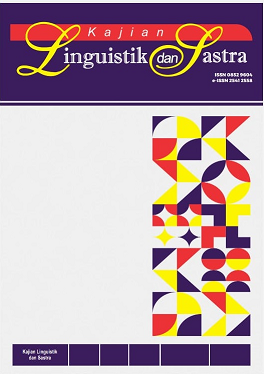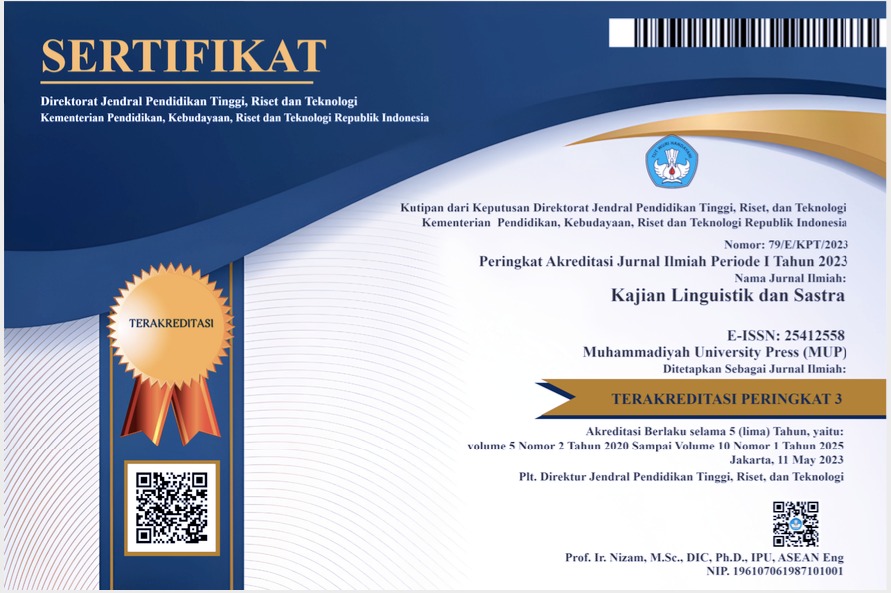Kesantunan Berbahasa Orang Tua dan Anak pada Youtube “Bolehkah Sekali Saja Kumenangis”
Abstract
This study aims to describe the form of politeness in language by Prilly and her father in a video entitled
Social Experiment: “Can I cry just once?" Episode 1-Prilly Latuconsina on the Sinemaku Pictures YouTube
channel and the influence of the use of politeness maxims in language to create emotional
communication between parents and children. The politeness of language between parents and children
is something that needs to be considered. The closeness factor often makes children forget the principles
of politeness when communicating with their parents. In analyzing the data, this study focuses on
compliance with the principles of politeness in language based on the theory developed by Leech. This
research is a type of qualitative descriptive research. The data source in this study comes from the social
experiment video "Can I cry just once?" Episode 1 on the Sinemaku Pictures YouTube channel in the form
of speech uttered by Prilly and her father. The results of this study indicate that there are several maxims
of politeness used by Prilly and her father, namely the maxim of humility, the maxim of appreciation,
the maxim of generosity, the maxim of sympathy, the maxim of appropriateness, and the maxim of
wisdom. The maxims most often used are the maxim of humility and the maxim of appreciation, so that
they can be a stimulus for the creation of emotional communication. This study can be a reference
related to the importance of politeness applied in communication between children and parents.
Downloads
References
[1] Iin Alviah, “Kesantunan Berbahasa dalam Tuturan Novel Para Priyayi Karya Umar Kayam,”
Seloka J. Pendidik. Bhs. dan Sastra Indones., vol. 3, no. 2, pp. 128–135, 2014, [Online].
Available: http://journal.unnes.ac.id/sju/index.php/seloka
[2] F. Laia, “Kesantunan Berbahasa Orangtua Dan Anak Dalam Lingkungan Keluarga Desa Orhili Susua,” Kohesi J. Pendidik. Bhs. dan Sastra Indones., vol. 4, no. 2, pp. 10–20, 2024,
doi: 10.57094/kohesi.v4i2.1566.
[3] K. K. Kusumaswarih, “Strategi Kesantunan Berbahasa dalam Pembelajaran Bahasa
Indonesia,” Belajar Bhs., vol. 3, no. 2, pp. 141–149, 2018, doi: 10.32528/bb.v3i2.1583.
[4] J. Rimbing and R. J. Kapoh, “Tindak Tutur Anak Remaja di Kabupaten Minahasa dalam
Percakapan Keluarga dan Penilaian Kesantunan Berbahasa,” J. Membaca, vol. 5, no. 1, pp.
43–52, 2020, [Online]. Available: http://jurnal.untirta.ac.id/index.php/jurnalmembaca
[5] Hestiyana, “Kesantunan Tindak Direktif pada Tuturan Anak dan Orang Tua di Desa
Ngumbul, Kabupaten Pacitan,” Madah, vol. 9, no. 1, pp. 101–116, 2018, doi: DOI:
10.26499/madah.v9i1.71.
[6] N. Amir and Tressyalina, “Prinsip Kesantunan Berbahasa dalam Kolom Komentar Kanal
Youtube Metronews dan Implikasinya terhadap Pembelajaran Teks Persuasi,” Alysis J.
Keislam. dan Pendidik., vol. 3, no. 2, pp. 100–114, 2023, doi:
https://doi.org/10.58578/alsys.v3i2.910.
[7] Sholihah, Santoso, and Winarsih, “Kesantunan Berbahasa dalam Gelar Wicara Muda
Beropini di Akun Youtube BKKBN Official,” J. Widyabastra J. Ilm. Pembelajaran Bhs. dan
Sastra Indones., vol. 11, no. 2, pp. 75–87, 2023, doi:
https://doi.org/10.25273/widyabastra.v11i2.19056 [17] Yenni, Yusriati, Sari, “Pola
Pengajaran Kesantunan Berbahasa Anak di Lingk.
[8] K. A. Seda, W. Gunawan, and R. D. D.-A. Muniroh, “Realisasi Strategi Kesantunan Positif
Dan Kesantunan Negatif Pada Podcast Youtube,” J. Ilm. Wahana Pendidik., vol. 2023, no.
15, pp. 259–267, 2023, [Online]. Available: https://doi.org/10.5281/zenodo.8207441
[9] E. Yenni, Y. Yusriati, and A. W. Sari, “Pola Pengajaran Kesantunan Berbahasa Anak di
Lingkungan Keluarga,” J. Tarb., vol. 25, no. 1, 2018, doi: 10.30829/tar.v25i1.238.
[10] N. K. Ratna, Teori, Metode, dan Teknik Penelitian Sastra. Yogyakarta: Pustaka Pelajar, 2013.
[11] A. F. R. Pratama and B. W. Setyawan, “Kesantunan Berbahasa pada Kajian Diskusi ‘Buat
Apa Menulis’ di Rayon Bahasa Avicenna (Prinsip Kesantunan Leech),” J. Ilm. Fonema
Edukasi Bhs. dan Sastra Indones., vol. 5, no. 2, pp. 82–103, 2022, doi: 10.2207/jjws.91.393.
[12] D. Pratiwi, S. S. Lestari, and S. Rosalina, “Analisis Peran Keluarga Bapak Yanto dalam
Meningkatkan Kemampuan Bahasa pada Anak,” J. Ilm. Wahana Pendidik., vol. 9, no. 18,
pp. 176–185, 2023, doi: DOI: https://doi.org/10.5281/zenodo.8310713.
[13] N. F. Ansar, A. Munir, and Haslinda, “Kesantunan Berbahasa dalam Lingkungan Masyarakat
di BTN Pelita Asri Palangga Gowa,” Aufklarung J. Kaji. Bahasa, Sastra Indones. dan
Pembelajarannya, vol. 1, no. 7, pp. 22–33, 2023, [Online]. Available: https://etdci.org/journal/AUFKLARUNG/article/view/778
[14] H. Gunawan and W. Hermansyah, “Maksim Kesantunan Berbahasa Penutur Bahasa
Samawa di Desa Labuhan Burung,” JISIP (Jurnal Ilmu Sos. dan Pendidikan), vol. 5, no. 4, pp.
1260–1269, 2021, doi: 10.58258/jisip.v5i4.2550.
[15] I. Kartina, “Kesantunan Berbahasa Dalam Konten Vlog Youtube Sherly Annavita Rahmi
(Deskripsi terhadap Pemakaian Bahasa Indonesia dalam Media Sosial),” Diksatrasia J. Ilm.
Pendidik. Bhs. dan Sastra Indones., vol. 5, no. 1, pp. 188–193, 2021, doi:
10.25157/diksatrasia.v5i1.6537.
[16] R. Nugroho, R. Wardiani, and H. Setiawan, “Kesantunan Berbahasa dalam Percakapan
Antarmahasiswa Semester Delapan STKIP PGRI Ponorogo,” J. Bhs. dan Sastra, vol. 8, no. 1,
pp. 37–43, 2021, [Online]. Available:
https://jurnal.lppmstkipponorogo.ac.id/index.php/JBS/article/view/85










